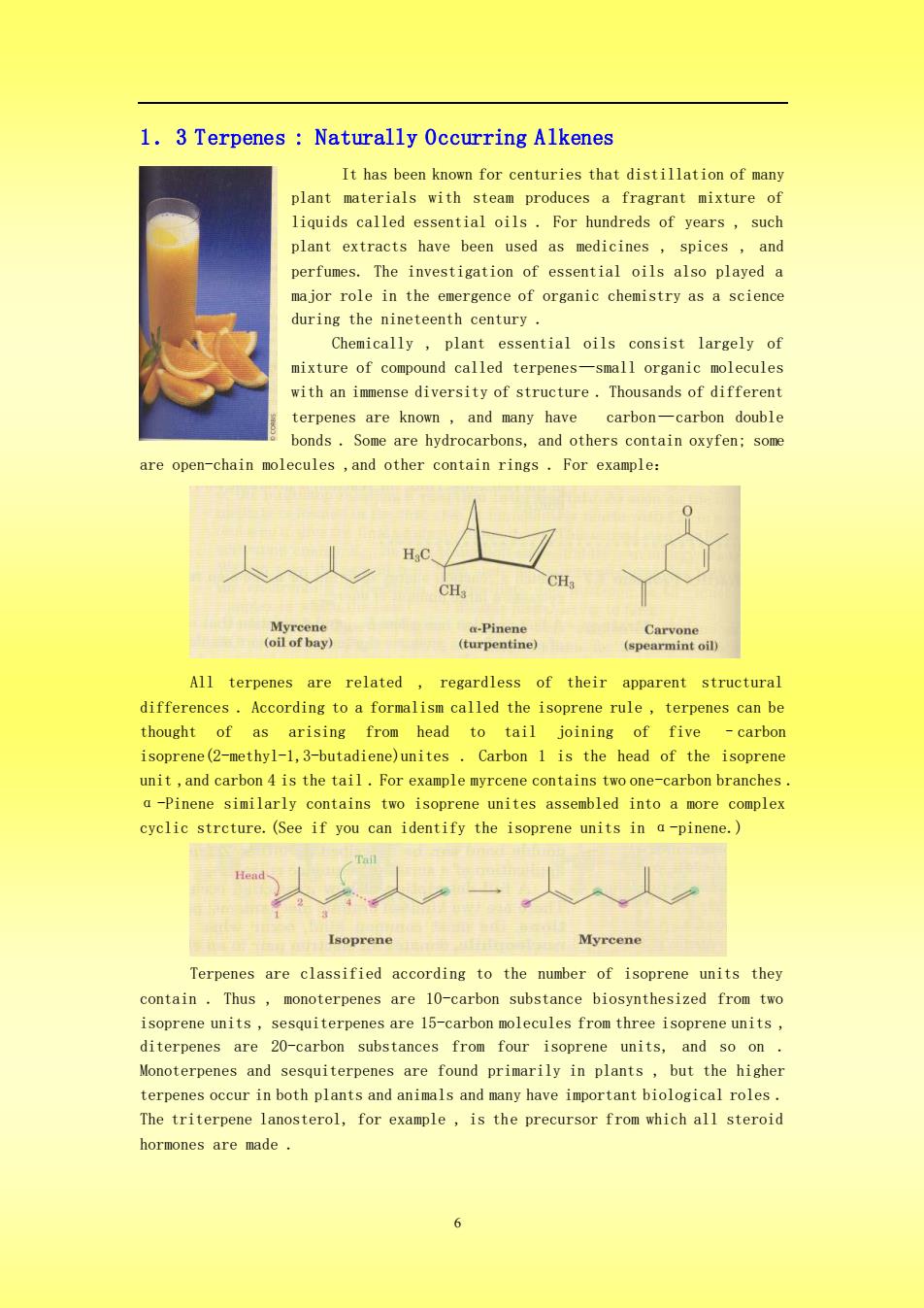
3Terpenes:Naturally Occurring Alkerthasor centuries that distillation of manyL.knownplant materials with steam produces a fragrant mixture ofliquids called essential oilsFor hundreds of yearssuchused as medicplant extractsshauananicesanigatimajor role in the emergence of organic chemistry as a scienceduring the nineteenth centuryChemically,plant essential oils consist largely ofmixtureof corlledterpenessmarganic moleculesnnoundesture.Thousafdifferentdiversity of strcarbon-carbon doubleterpenes areknown,and many haveoondsare hydrocarbons, and others contain oxyfen; somsome open-chainmolecules ,and other contain ringsormple(oilofbay(turpentinepearmint dicturterpenescan beHifferences.a formalism cald the isoprerrule.arbonthoughtrisintailoining3-buteneunieheacoprepcyclicstrcture.y the isoprene units ipinene.)Tvouerpenes are classifaccordinsunitstheontairterneare 10-carbon substance biosynthesed from tsoprunits1car15-narthreaSunitterpelothplantsandanimalsandmanyhaveimporfanthlologlcaroletriterpene lanosterol,orexamples theprecursorfrom whichall sterohormones are made
6 1.3 Terpenes : Naturally Occurring Alkenes It has been known for centuries that distillation of many plant materials with steam produces a fragrant mixture of liquids called essential oils . For hundreds of years , such plant extracts have been used as medicines , spices , and perfumes. The investigation of essential oils also played a major role in the emergence of organic chemistry as a science during the nineteenth century . Chemically , plant essential oils consist largely of mixture of compound called terpenes—small organic molecules with an immense diversity of structure . Thousands of different terpenes are known , and many have carbon—carbon double bonds . Some are hydrocarbons, and others contain oxyfen; some are open-chain molecules ,and other contain rings . For example: All terpenes are related , regardless of their apparent structural differences . According to a formalism called the isoprene rule , terpenes can be thought of as arising from head to tail joining of five –carbon isoprene(2-methyl-1,3-butadiene)unites . Carbon 1 is the head of the isoprene unit ,and carbon 4 is the tail . For example myrcene contains two one-carbon branches . α-Pinene similarly contains two isoprene unites assembled into a more complex cyclic strcture.(See if you can identify the isoprene units in α-pinene.) Terpenes are classified according to the number of isoprene units they contain . Thus , monoterpenes are 10-carbon substance biosynthesized from two isoprene units , sesquiterpenes are 15-carbon molecules from three isoprene units , diterpenes are 20-carbon substances from four isoprene units, and so on . Monoterpenes and sesquiterpenes are found primarily in plants , but the higher terpenes occur in both plants and animals and many have important biological roles . The triterpene lanosterol, for example , is the precursor from which all steroid hormones are made
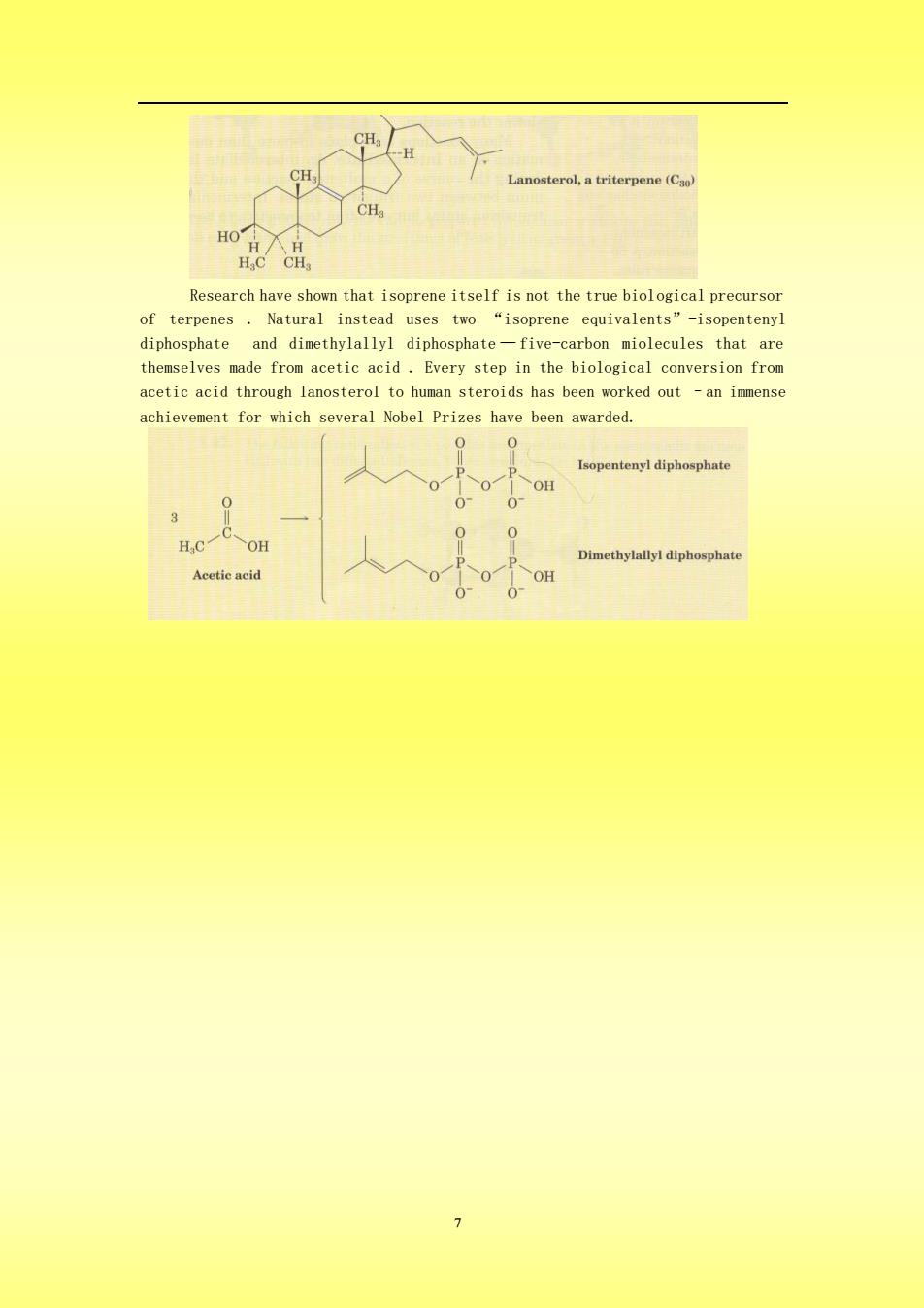
Research have shown that isoprene itself is not the true biological precursorof terpenes.Naturainstead usesisoprene equivalentisopentenyldiphosphateand dimethylallyl diphosphate-five-carbon miolecules that arethemselves made from acetic acid.Every step in the biological conversion fromterol to human steroids has been worked outacetic acidthrouganimmenseeveral Nobel Prizes have been awardedachjevemenfor.whichpentenyl diphosphateCHOmethylallyl diphosphateAcetic acid
7 Research have shown that isoprene itself is not the true biological precursor of terpenes . Natural instead uses two “isoprene equivalents”-isopentenyl diphosphate and dimethylallyl diphosphate — five-carbon miolecules that are themselves made from acetic acid . Every step in the biological conversion from acetic acid through lanosterol to human steroids has been worked out –an immense achievement for which several Nobel Prizes have been awarded
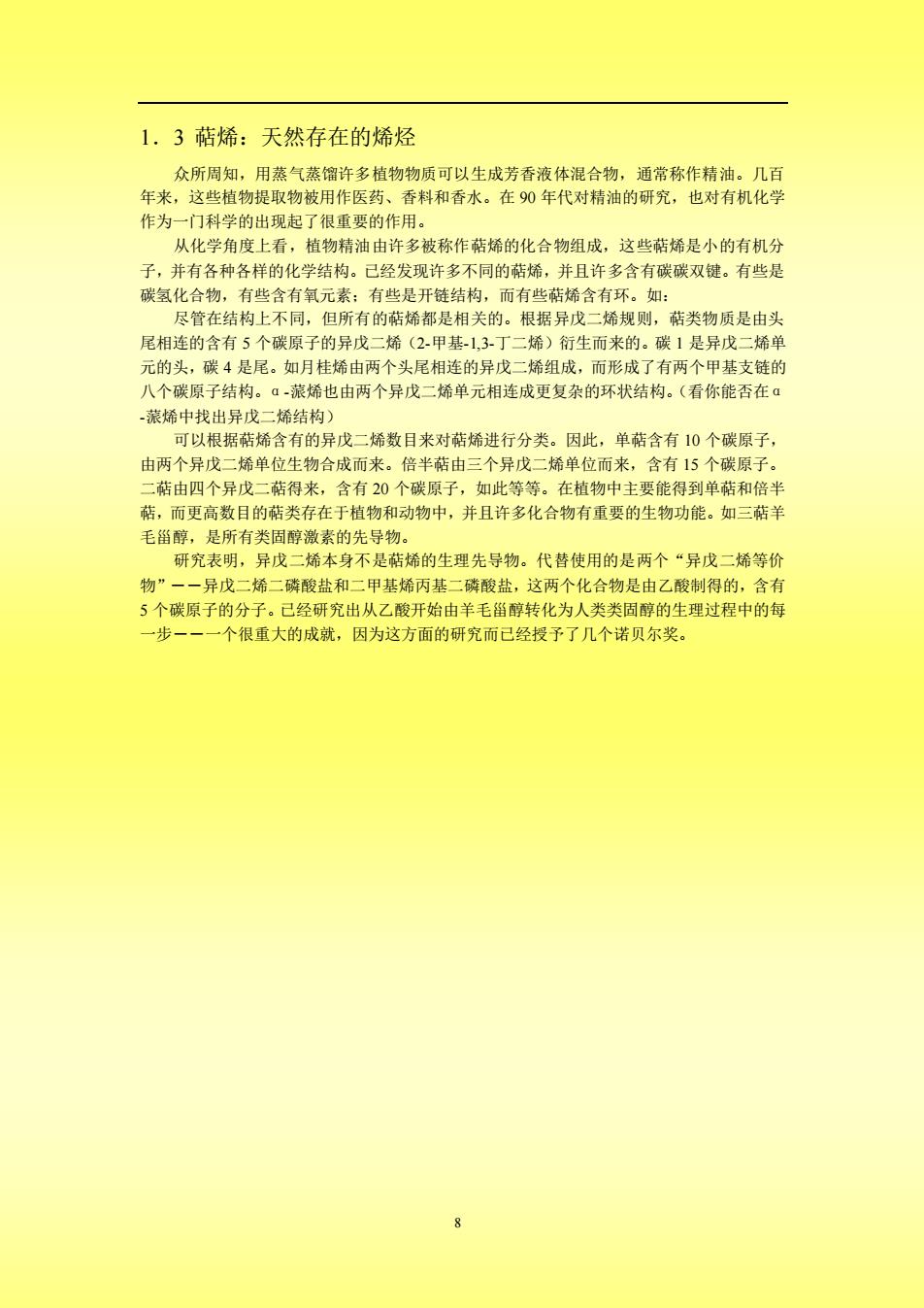
1.3烯:天然存在的烯烃众所周知,用蒸气蒸馏许多植物物质可以生成芳香液体混合物,通常称作精油。几百年来,这些植物提取物被用作医药、香料和香水。在90年代对精油的研究,也对有机化学作为一门科学的出现起了很重要的作用。从化学角度上看,植物精油由许多被称作菇烯的化合物组成,这些烯是小的有机分子,并有各种各样的化学结构。已经发现许多不同的烯,并且许多含有碳碳双键。有些是碳氢化合物,有些含有氧元素:有些是开链结构,而有些粘烯含有环。如:尽管在结构上不同,但所有的烯都是相关的。根据异戊二烯规则,类物质是由头尾相连的含有5个碳原子的异戊二烯(2-甲基-1,3-丁二烯)衍生而来的。碳1是异戊二烯单元的头,碳4是尾。如月桂烯由两个头尾相连的异戊一烯组成,而形成了有两个甲基支链的八个碳原子结构。α-烯也由两个异戊二烯单元相连成更复杂的环状结构。(看你能否在α-烯中找出异戊二烯结构)可以根据烯含有的异戊二烯数目来对烯进行分类。因此,单含有10个碳原子,由两个异戊二烯单位生物合成而来。倍半由三个异戊二烯单位而来,含有15个碳原子。二由四个异戊二菇得来,含有20个碳原子,如此等等。在植物中主要能得到单和倍半,而更高数目的类存在于植物和动物中,并且许多化合物有重要的生物功能。如三羊毛笛醇,是所有类固醇激素的先导物。研究表明,异戊二烯本身不是烯的生理先导物。代替使用的是两个“异戊二烯等价物一异戊二烯二磷酸盐和二甲基烯丙基二磷酸盐,这两个化合物是由乙酸制得的,含有5个碳原子的分子。已经研究出从乙酸开始由羊毛留醇转化为人类类固醇的生理过程中的每一个很重大的成就,因为这方面的研究而已经授予了几个诺贝尔奖北
8 1.3 萜烯:天然存在的烯烃 众所周知,用蒸气蒸馏许多植物物质可以生成芳香液体混合物,通常称作精油。几百 年来,这些植物提取物被用作医药、香料和香水。在 90 年代对精油的研究,也对有机化学 作为一门科学的出现起了很重要的作用。 从化学角度上看,植物精油由许多被称作萜烯的化合物组成,这些萜烯是小的有机分 子,并有各种各样的化学结构。已经发现许多不同的萜烯,并且许多含有碳碳双键。有些是 碳氢化合物,有些含有氧元素;有些是开链结构,而有些萜烯含有环。如: 尽管在结构上不同,但所有的萜烯都是相关的。根据异戊二烯规则,萜类物质是由头 尾相连的含有 5 个碳原子的异戊二烯(2-甲基-1,3-丁二烯)衍生而来的。碳 1 是异戊二烯单 元的头,碳 4 是尾。如月桂烯由两个头尾相连的异戊二烯组成,而形成了有两个甲基支链的 八个碳原子结构。α-蒎烯也由两个异戊二烯单元相连成更复杂的环状结构。(看你能否在α -蒎烯中找出异戊二烯结构) 可以根据萜烯含有的异戊二烯数目来对萜烯进行分类。因此,单萜含有 10 个碳原子, 由两个异戊二烯单位生物合成而来。倍半萜由三个异戊二烯单位而来,含有 15 个碳原子。 二萜由四个异戊二萜得来,含有 20 个碳原子,如此等等。在植物中主要能得到单萜和倍半 萜,而更高数目的萜类存在于植物和动物中,并且许多化合物有重要的生物功能。如三萜羊 毛甾醇,是所有类固醇激素的先导物。 研究表明,异戊二烯本身不是萜烯的生理先导物。代替使用的是两个“异戊二烯等价 物”――异戊二烯二磷酸盐和二甲基烯丙基二磷酸盐,这两个化合物是由乙酸制得的,含有 5 个碳原子的分子。已经研究出从乙酸开始由羊毛甾醇转化为人类类固醇的生理过程中的每 一步――一个很重大的成就,因为这方面的研究而已经授予了几个诺贝尔奖
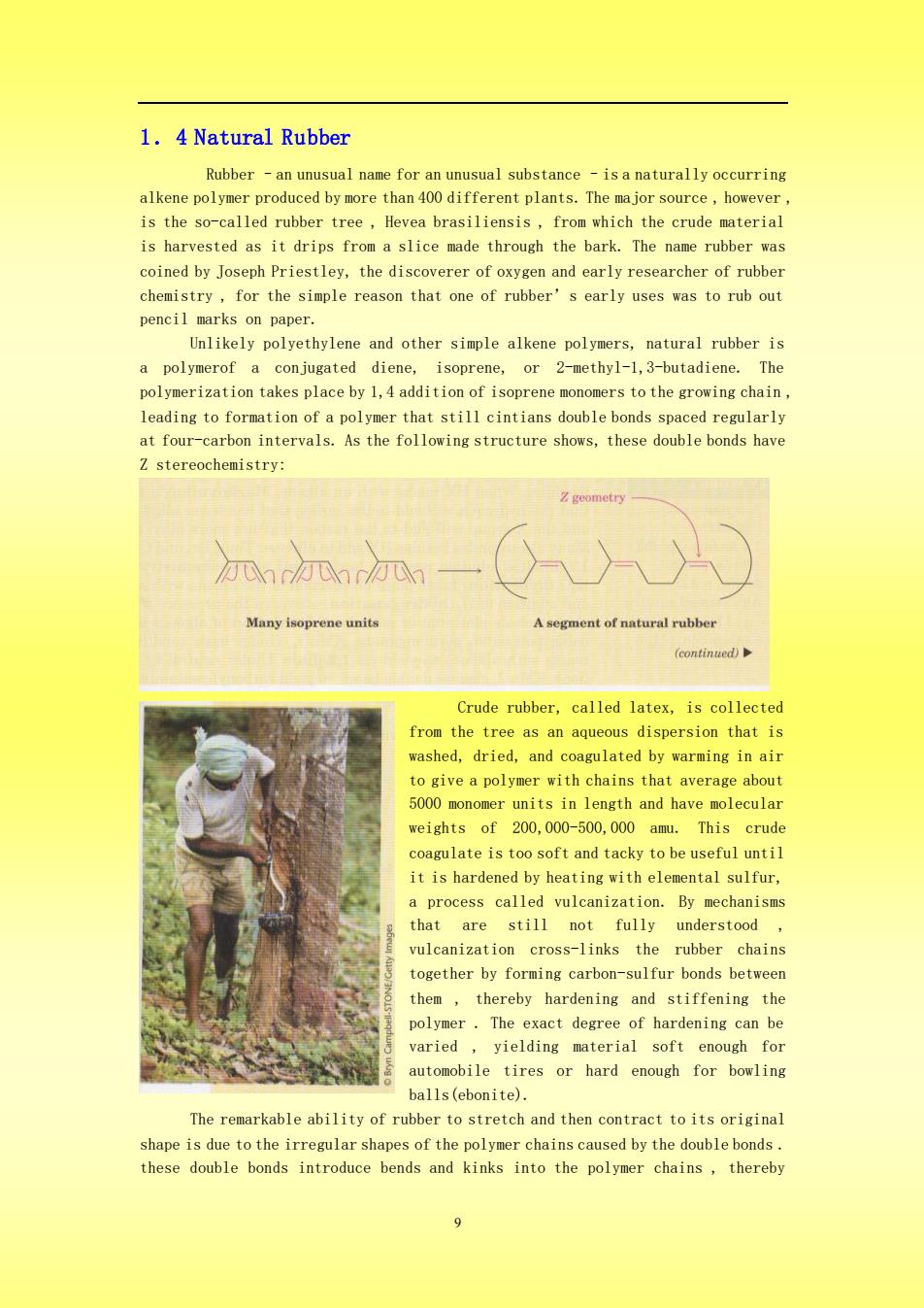
4 Natural RubbelRubber-an unusual namusualsubstanceanaturallyoccurringalkenepolymerproducedbymorethan4oodifferentplants.Themajor source,howeveris the so-called rubber tree,Hevea brasiliensis, from which the crude materialis harvested asit drips from a slice made through the bark. The narubber washeand earlyresearcher of rubbechemistryfor the simple reason that one of rubber' s early uses was to rub outpencil marks on paperUnlikely polyethylene and other simple alkene polymers, natural rubber isapolymerofaconjugateddiene,isoprene,or:2-methyl-1,3-butadiene.Thepolymerization takes place by l,4 addition of isoprene monomers to the growing chainleading to forion of a polymer that still cintians double bonds spaced regularlat four-carbon intervals. As the following structure shows, these double bonds haveZstereochemistryMany isopreneunitsAsegment of natural rubbeontinuedCrude rubber, caiscollecteofrom the tree as an aqusionthatiswashed,dried,aand coagulaoywarminginainlymerwith chains thato giveabo5000velghcoagulateioosoftandtaoseful untiit is hardened byheatingwth elemental sulfur,a process called vulcanizationchanismtogether by formibetweethemtherebyhardeninandtiffening thepolymerThe exact degree ofcanbevariedyielding material soft enough formobile tires or hard enoughfowlinballs(ebonite)The remarkable ability of rubber to stretch and then contract to its originalshape is due to the irregular shapes of the polymer chains caused by the double bondsthese double bonds introduce bends and kinks into the polymer chains , thereby
9 1.4 Natural Rubber Rubber –an unusual name for an unusual substance –is a naturally occurring alkene polymer produced by more than 400 different plants. The major source , however , is the so-called rubber tree , Hevea brasiliensis , from which the crude material is harvested as it drips from a slice made through the bark. The name rubber was coined by Joseph Priestley, the discoverer of oxygen and early researcher of rubber chemistry , for the simple reason that one of rubber’s early uses was to rub out pencil marks on paper. Unlikely polyethylene and other simple alkene polymers, natural rubber is a polymerof a conjugated diene, isoprene, or 2-methyl-1,3-butadiene. The polymerization takes place by 1,4 addition of isoprene monomers to the growing chain , leading to formation of a polymer that still cintians double bonds spaced regularly at four-carbon intervals. As the following structure shows, these double bonds have Z stereochemistry: Crude rubber, called latex, is collected from the tree as an aqueous dispersion that is washed, dried, and coagulated by warming in air to give a polymer with chains that average about 5000 monomer units in length and have molecular weights of 200,000-500,000 amu. This crude coagulate is too soft and tacky to be useful until it is hardened by heating with elemental sulfur, a process called vulcanization. By mechanisms that are still not fully understood , vulcanization cross-links the rubber chains together by forming carbon-sulfur bonds between them , thereby hardening and stiffening the polymer . The exact degree of hardening can be varied , yielding material soft enough for automobile tires or hard enough for bowling balls(ebonite). The remarkable ability of rubber to stretch and then contract to its original shape is due to the irregular shapes of the polymer chains caused by the double bonds . these double bonds introduce bends and kinks into the polymer chains , thereby
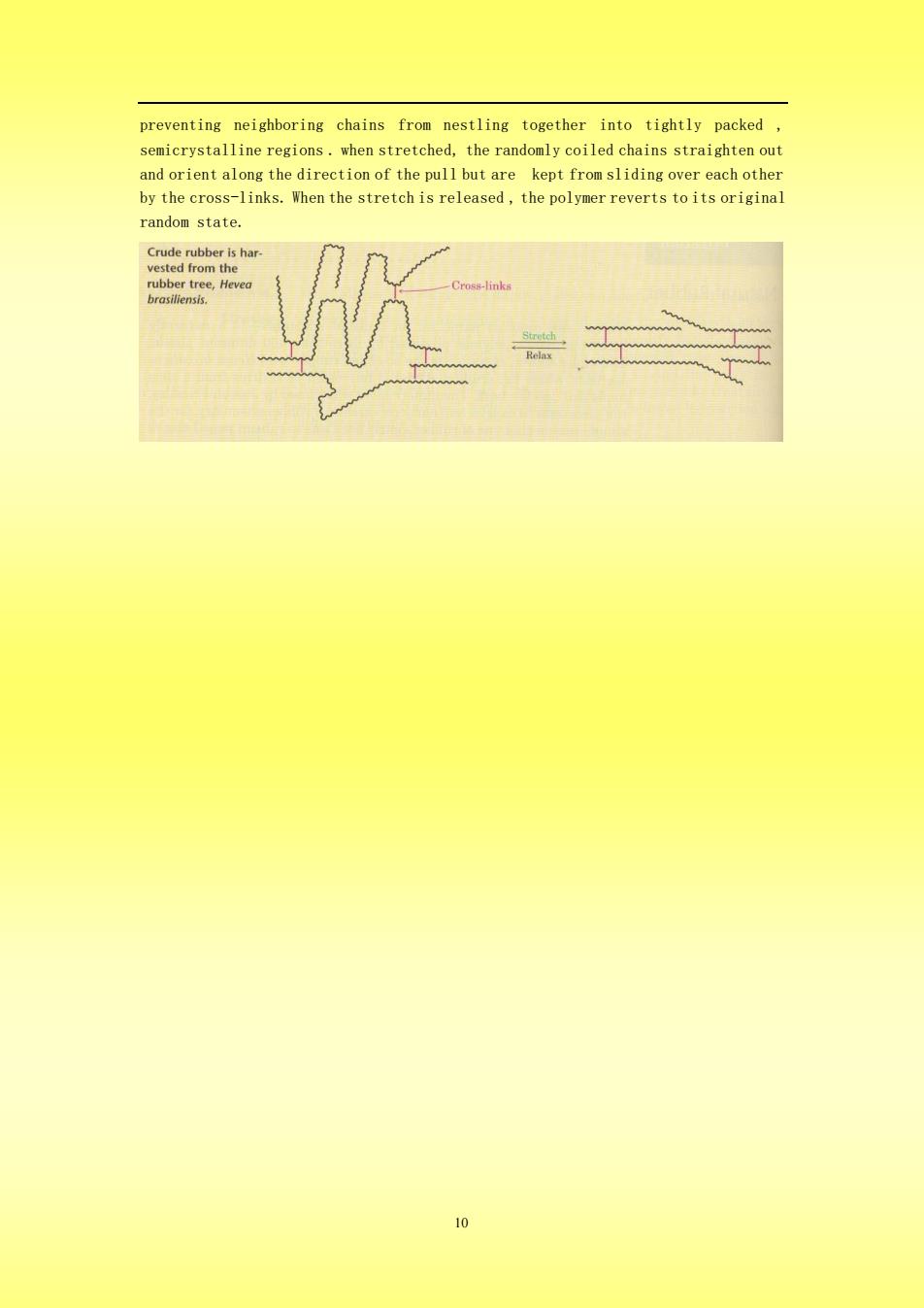
preventing neighboring chains from nestling together into tightly packed,semicrystalline regions.when stretched, the randomly coiled chains straighten outand orient along the direction of the pull but arekept from sliding over each otherby the cross-links. Whenthe stretchisreleased,the polymerreverts toits originalrandom stateCFvestebrasili
10 preventing neighboring chains from nestling together into tightly packed , semicrystalline regions . when stretched, the randomly coiled chains straighten out and orient along the direction of the pull but are kept from sliding over each other by the cross-links. When the stretch is released , the polymer reverts to its original random state